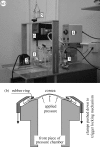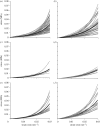Characterization of age-related variation in corneal biomechanical properties
- PMID: 20392712
- PMCID: PMC2935603
- DOI: 10.1098/rsif.2010.0108
Characterization of age-related variation in corneal biomechanical properties
Abstract
An experimental study has been conducted to determine the stress-strain behaviour of human corneal tissue and how the behaviour varies with age. Fifty-seven well-preserved ex vivo donor corneas aged between 30 and 99 years were subjected to cycles of posterior pressure up to 60 mm Hg while monitoring their behaviour. The corneas were mechanically clamped along their ring of scleral tissue and kept in physiological conditions of temperature and hydration. The tissue demonstrated hyper-elastic pressure-deformation and stress-strain behaviour that closely matched an exponential trend. Clear stiffening (increased resistance to deformation) with age was observed in all loading cycles, and the rate of stiffness growth was nonlinear with bias towards older specimens. With a strong statistical association between stiffness and age (p < 0.05), it was possible to develop generic stress-strain equations that were suitable for all ages between 30 and 99 years. These equations, which closely matched the experimental results, depicted corneal stiffening with age in a form suitable for implementation in numerical simulations of ocular biomechanical behaviour.
Figures






Similar articles
-
Assessment of corneal biomechanical properties and their variation with age.Curr Eye Res. 2007 Jan;32(1):11-9. doi: 10.1080/02713680601077145. Curr Eye Res. 2007. PMID: 17364730
-
Assessment of the ex vivo biomechanical properties of porcine cornea with inflation test for corneal xenotransplantation.J Med Eng Technol. 2012 Jan;36(1):17-21. doi: 10.3109/03091902.2011.629276. Epub 2011 Nov 15. J Med Eng Technol. 2012. PMID: 22085017
-
Biomechanical contribution of the sclera to dynamic corneal response in air-puff induced deformation in human donor eyes.Exp Eye Res. 2020 Feb;191:107904. doi: 10.1016/j.exer.2019.107904. Epub 2019 Dec 25. Exp Eye Res. 2020. PMID: 31883460 Free PMC article.
-
Age-related variations in the biomechanical properties of human sclera.J Mech Behav Biomed Mater. 2012 Dec;16:181-91. doi: 10.1016/j.jmbbm.2012.10.011. Epub 2012 Nov 6. J Mech Behav Biomed Mater. 2012. PMID: 23182387
-
Assessment of corneal biomechanical behavior under posterior and anterior pressure.J Refract Surg. 2013 Jan;29(1):64-70. doi: 10.3928/1081597X-20121228-05. J Refract Surg. 2013. PMID: 23311744
Cited by
-
Corneal biomechanical responses detected using corvis st in primary open angle glaucoma and normal tension glaucoma.Medicine (Baltimore). 2020 Feb;99(7):e19126. doi: 10.1097/MD.0000000000019126. Medicine (Baltimore). 2020. PMID: 32049829 Free PMC article.
-
Corneal Biomechanical Properties in Varying Severities of Myopia.Front Bioeng Biotechnol. 2021 Jan 21;8:595330. doi: 10.3389/fbioe.2020.595330. eCollection 2020. Front Bioeng Biotechnol. 2021. PMID: 33553113 Free PMC article.
-
Factors Associated With Receipt of Crosslinking for Keratoconus.Cornea. 2024 Feb 1;43(2):214-220. doi: 10.1097/ICO.0000000000003353. Epub 2023 Jul 27. Cornea. 2024. PMID: 37506367 Free PMC article.
-
Multiple Optical Elastography Techniques Reveal the Regulation of Corneal Stiffness by Collagen XII.Invest Ophthalmol Vis Sci. 2022 Nov 1;63(12):24. doi: 10.1167/iovs.63.12.24. Invest Ophthalmol Vis Sci. 2022. PMID: 36383352 Free PMC article.
-
Time Course Changes of the Mechanical Properties of the Iris Pigment Epithelium in a Rat Chronic Ocular Hypertension Model.Biomed Res Int. 2018 Oct 21;2018:4862309. doi: 10.1155/2018/4862309. eCollection 2018. Biomed Res Int. 2018. PMID: 30420963 Free PMC article.
References
Publication types
MeSH terms
Grants and funding
LinkOut - more resources
Full Text Sources

